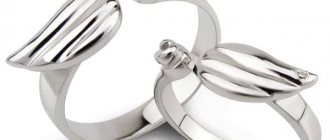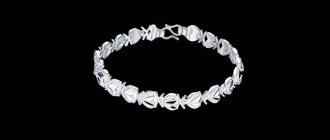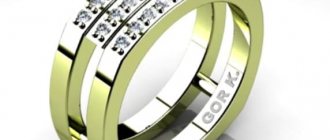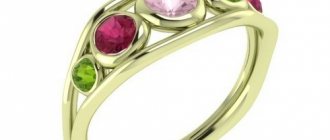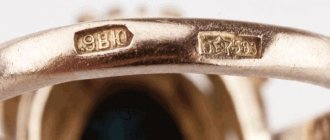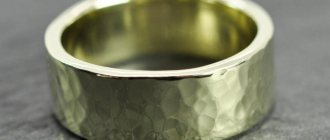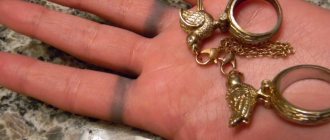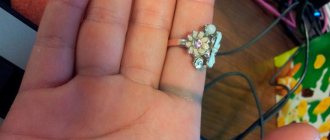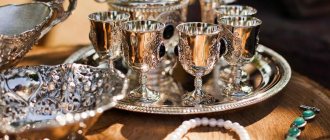Materials such as green gold are increasingly being used to make jewelry. It is an alloy of the usual yellow metal with silver, sometimes diluted with a small amount of copper and other components to obtain different shades.
Such gold is used both for the manufacture of entire jewelry and as a material for decorative inserts in them.
History of gold
Some alloys have been known for a very long time. For example, white gold with the addition of nickel, palladium and platinum, or red gold with copper and zinc. In Russia, red gold used to be called chervonets, which is where the name of the gold coins “chervonetsy” came from. Nowadays, the flight of design ideas in jewelry has gone very far.
The most fashionable now is rose gold with the addition of silver and copper. Products made from it have a delicate yellow color with a pink tint and are very expensive. The secrets of black and chocolate gold obtained in the 80s of the 20th century are known only to its inventors and are not revealed to anyone; such things are extremely rare.
Purple (violet or amethyst) comes with the addition of aluminum. It is very fragile and therefore is used only as inserts in jewelry or exhibits for international exhibitions. Blue or cyan color is obtained when combined with indium and gallium, such things are rare, very unusual and look like jewelry from space aliens.
Application of this alloy
Jewelry of 585 standard with the addition of copper and silver is used by jewelers to make women's jewelry and tie clips. The resulting products attract the eye with a soft silvery-greenish glow.
To create original and unusual jewelry, they combine electrum with different ligature contents. As a result, the structure can shimmer with a whole spectrum of different shades of green. You can also often find similar jewelry interspersed with precious stones.
750 standard green gold is used to make both jewelry and a variety of souvenirs.
Green gold what is it
But today we will talk about green gold or electrum, which was used by the inhabitants of ancient Egypt and the Mediterranean coast. Electrum gets its name from the ancient Greek name for amber, as it has a brilliant yellow color with a green tint, often found in some varieties of the natural mineral.
It is a natural alloy of gold and silver. Deposits of this native gold were first found on the island of Crete, and then in other areas of the Mediterranean. As Pliny the Elder wrote, “all gold contains silver in varying quantities, when the share of silver is 55%, the metal is called electrum.” The inhabitants of pre-Columbian America also knew green gold, who widely used precious metals for ritual needs and knew how to make alloys of gold and silver
Electrum was first mentioned in the chronicles about the campaign of the Egyptian pharaoh of the V dynasty Sahura to the country of Punt (East Africa). The Egyptians, among other exotic goods, brought from there green gold, which was used to cover the tops of pyramids and obelisks so that they would shine with divine light in the sun; many of the famous jewelry of the pharaohs were made of electrum.
In the 6th century BC, the world's first gold coins with the royal seal on the obverse began to be produced in Lydia, in what is now Turkey. Coins found in excavations in the city of Ephesus on the site of the ancient Temple of Artemis proved that they were also made of electrum. It is believed that the first analysis of the percentage of gold in an alloy was carried out by Archimedes. The famous legend of taking a bath and exclaiming “Eureka” tells how a scientist was able to determine how much gold and how much silver was contained in coins brought in for testing.
Green gold - colors and hallmarks
Jewelry art began to develop very actively at the end of the 19th century. The classics became outdated and things in the Art Nouveau style began to come into fashion, which required new materials and forms. We experimented with various and not always safe additives to classic gold. In modern jewelry, many types of ligatures are used to produce not only green gold, but also other colors of the precious metal.
Ligatures (translated from Latin as “connection”) are various additives to molten gold to facilitate processing, improve quality, add color and obtain the desired sample. To obtain a light green color, 23% copper and 2% cadmium were added to gold, and dark green was obtained by adding 15% silver, 6% copper and 4% cadmium.
More about products
In Guatemala, a spice called cardamom is very popular. This plant is even called green gold, since exports bring the lion's share of profits to Guatemalans. In our country, green gold is a special alloy of precious material. And although, due to stereotypical thinking, products made from this metal are not very popular, jewelers still offer an assortment of jewelry with a green tint.
Green gold ring with stone
A green gold ring framed with green stones looks elegant and original. Jewelers offer rings with green amethysts, agates, and emeralds. In eastern countries, bottle-colored agate is considered a symbol of masculinity and bravery. Thanks to the chlorides that make up the agate stone, the shade of the mineral changes from light to rich.
There is no emerald-colored amethyst in nature, but after chemical treatment, the natural purple mineral acquires a green color. The best settings for this stone are traditional yellow, white or bottle-colored gold and silver. Amethyst rings are recommended to be given to men as a talisman against drunkenness. Green amethyst in gold looks amazing, which is confirmed by the photo.
If you want to protect a loved one from vision impairment, give a green gold bracelet decorated with emeralds. For a long time, this stone was considered healing. The unparalleled beauty and healing properties make this mineral one of the most sought after. And in combination with green gold, emerald looks even more attractive. Gold in green stones looks mesmerizing, as we can see by looking at the photo.
Toxic green gold - attention!
However, in 2000, Russia and the European Union banned the use of cadmium additive due to its high toxicity. When inhaling molten cadmium vapor during the production and accumulation of harmful metal in the body from constant wearing of such products, a person develops oncology.
In some countries that supply jewelry to the world market, there is no such ban, and therefore it is important to pay attention to the labeling when purchasing an item. Jewelry containing the following samples is considered safe:
- ZlSr 585-415 (bright green color).
- ZlSrM 585-300 (yellow with a faint green tint).
Now, to give the desired shades, potassium, zinc, silver, and copper are added in different proportions. The sample is set depending on the percentage of gold contained in the alloy.
585 means 58% gold, and 750 means 75% precious metal. There is also 960 standard - this is gold leaf used for gilding.
Nickel was previously used to make white gold, and this alloy caused an allergic reaction in some people. Now nickel has been replaced with hypoallergenic palladium. Jewelers are increasingly collaborating with chemists and allergists to produce beautiful precious and at the same time safe alloys.
Jewelry requirements
Processing green gold requires high-level craftsmanship, patient work, knowledge and experience from the jeweler. That is why jewelers have certain requirements for this capricious alloy.
First of all, the metal must be passive to chemical reactions with air and other substances that are easily accessible to the average person in everyday life. For example, gold in combination with rubidium or cadmium has a negative impact on human health and can even leave a chemical burn on the skin.
Green metal must have sufficient ductility and resistance to mechanical stress. Otherwise, the jewelry will turn out to be very short-lived. The alloy must also have sufficient hardness to successfully undergo jewelry processing.
Very rarely, jewelers can use nickel as a ligature to obtain a precious green alloy. This metal simultaneously gives gold the strength needed for processing and a grassy tone. But when wearing such jewelry every day, there is a small percentage of the likelihood of allergic reactions.
Green gold jewelry
The most popular among buyers is the mysteriously transparent light green shade, but in Russia it is not in great demand. Our lovers of gold jewelry traditionally prefer classic yellow or metal with a reddish tint, considering colored gold too similar to cheap jewelry.
Quite often in stores you can find rings, earrings, pendants and tie pins with colored gold inserts, which makes the product original. Things that combine green gold with white look very stylish. If an item is made entirely of electrum, it is undesirable to wear it every day due to fragility and rapid wear. It should be stored very carefully, without pressing or dropping it, this can lead to destruction of the jewelry, and it is better to clean it in a jewelry workshop.
Use of metal
Jewelers use this material to make a wide variety of jewelry: rings, bracelets, pendants, earrings, brooches, clips, hair accessories, cufflinks, necklaces and chains.
18k green gold is also used as the basis for souvenirs, awards, orders, corporate badges and enamel products. Unlike many other types of colored gold, it can be used as a base for jewelry. Jewelry made from this unusual alloy looks very exotic and seems to glow with a soft greenish light.
Unfortunately, only dull versions of electrum can be used to create an entire ring or bracelet. Mixtures with a deep green tint are usually too brittle or toxic to be useful. Nevertheless, inserts, overlays and individual elements of jewelry are sometimes made from them.
The combination of several types of green gold with each other, as well as their combination with other alloys and intermetallic compounds of different shades, looks very beautiful. The contrast between the two metals makes the jewelry unusual, and the harmonious combination of colors gives it tenderness. At the same time, a product made of such gold will almost never look too bright or vulgar, unlike classic yellow jewelry, which is quite easy to “overload”.
The noble green metal also goes well with many precious, semi-precious and decorative stones: from emeralds and sapphires to quartz and crystal. They can be used either as small inserts or as the main element, the beauty of which will be emphasized by a more modest-looking metal.
Plant and floral motifs are very popular in electrum products. Often in jewelry you can see inserts in the form of leaves, stems, tree crowns, vines, twigs, grapes, and so on. But there are also more austere works without any additional decorations.
Green gold is a rather rare and unusual material , which is why mass production of jewelry made from it is rare. Most of the jewelry is unique handicrafts by various craftsmen, which adds even more value and exoticism to it. However, an inexperienced person can easily mistake them for jewelry, which is the main reason for the low popularity of the alloy.
Green gold price
The price of green gold is, by and large, the same as the price of regular gold of the same standard. As of June 2022, this is approximately 3,100 rubles per 1 gram of the 750th sample and 2,400 rubles per 1 gram of the 585th sample. But we also need to take into account the cost of the master’s work. Indeed, due to the fragility and other difficulties in processing electrum, products made from it will cost more.
Today on the market, and especially in online trading, there are a lot of counterfeit goods. The same trends can be seen in the jewelry trade. According to statistics, out of 10 jewelry, 4 will be fake. Therefore, you should make such expensive purchases only in trusted stores and preferably after consultation with a highly qualified specialist whom you trust.
How to spot a fake
If you really liked something not in a branded jewelry store and there is no specialist nearby with whom you can consult, then remember a few simple tips that can save your money and nerves.
- Marking. Never buy a product without a sample and do not listen to fairy tales that it was supposedly made for yourself from a jeweler you know and therefore there is no sample. They are definitely trying to sell you a fake.
- Magnet. Attach any magnet to the ring or earrings. If it is real gold of any standard, it will never be magnetized.
- Resistant to iodine or alcohol. If you rub one of these liquids on a fake, it will immediately tarnish, but real gold will not.
- Weight. Fake gold is always lighter than real gold, although it is very difficult to determine this by eye.
- Color. When purchasing green gold jewelry, pay attention to the color.
Very bright, deep green, means either counterfeit or smuggled from a country that allows the use of toxic ligatures that are dangerous to your health, such as Guatemala. The real products will have a very soft light green color. We wish you pleasant shopping and the joy of owning beautiful jewelry!
If you liked the article, share it on social networks. This is important to us, thank you
Tags:Green gold: what is it, differences from fakes, green gold purity
Reviews
Caroline:
“My husband gave me a set of green gold jewelry for our wedding anniversary. Indescribable beauty. I wear it on holidays, and the effect is always stunning.”
Victoria:
“They gave me a green bracelet and earrings. Until they explained what it was, I thought it was ordinary jewelry.”
Anya:
“I already have a collection of green gold jewelry. Of course, they need good care (so as not to knock or spoil them with some kind of chemical), but it’s worth it.”
